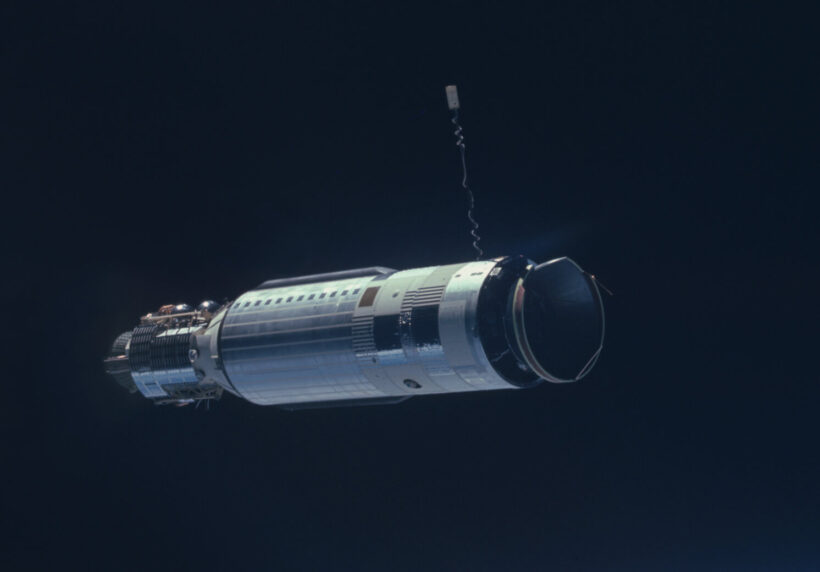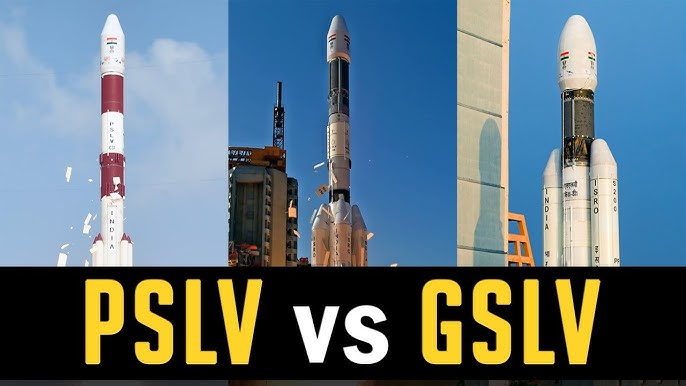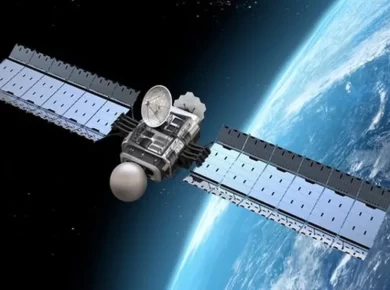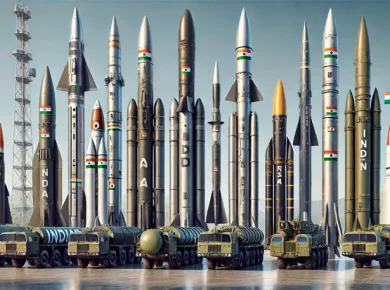Launch Vehicles for Satellites & Space Probes
- Launch Vehicles are used to transport and put satellites & space probes into space
- Satellites Orbits Height Classification to under different types of launch vehicles
| Lower earth orbit | 180 km – 2000 km | Sun synchronous orbit, Polar Orbit |
| Mid earth orbit | 2000 km – 35780 km | GPS & Navigation |
| High earth orbit | > 35780 km | Geostationary orbit |
- The first Indian experimental Satellite Launch Vehicle (SLV-3) was developed in 1980
- An Augmented version of this, ASLV, was launched successfully in 1992
India has made tremendous progress in launch vehicle technology & has achieved self-reliance in satellite launch vehicle programme with the operationalisation of Polar Satellite Launch Vehicle (PSLV) and Geosynchronous Satellite Launch Vehicle (GSLV).
Satellite Launch Vehicle (SLV)
- The Satellite Launch Vehicle (SLV) project was born out of the need for achieving indigenous satellite launch capability
- SLV3, India’s first experimental launch vehicle, was capable of placing 40 kg class payloads in Low Earth Orbit (LEO)
- It was a four-stage rocket with all solid-propellant motors – weighing 17 tonnes with a height of 22 m
- The launch on July 18, 1980 from Sriharikota Range, successfully placed Rohini satellite, into the orbit, thereby making India the sixth member of an exclusive club of space-faring
The successful culmination of the SLV-3 project showed the way to advanced launch vehicle projects such as the Augmented Satellite Launch Vehicle (ASLV), Polar Satellite Launch Vehicle (PSLV) and the Geosynchronous satellite Launch Vehicle (GSLV)
Augmented Satellite Launch Vehicle (ASLV)
- The Augmented Satellite Launch Vehicle (ASLV) Programme was designed to augment the payload capacity to 150 kg, thrice that of SLV-3, for Low Earth Orbits (LEO).
- With a lift off weight of 40 tonnes, the 23.8 m tall ASLV was configured as a five stage, all-solid propellant vehicle to Low Earth Orbit (LEO)
Polar Satellite Launch Vehicle (PSLV)
- PSLV is capable of launching 1750 kg satellites in sun-synchronous polar orbit and 1425 kg satellite in geo-synchronous transfer orbit.
- It measures 44.4 m tall, with a lift off weight of 320 tonnes & known as the Workhorse of ISRO
- PSLV has four stages using solid and liquid propulsion systems alternately
- PSLV has proved its multi-payload, multi-mission capability in a single launch and its geosynchronous launch capability
- Launched Missions > Chandrayaan-1, Mars Orbiter Mission, Space Capsule Recovery Experiment, IRNSS, Astrosat
Geosynchronous Satellite Launch Vehicle (GSLV)
- The Geosynchronous Satellite Launch Vehicle (GSLV) was primarily developed to launch INSAT class of satellites into Geosynchronous Transfer Orbits.
- Presently GSLV is being used for launching GSAT series of satellites.
- GSLV is capable of placing 2 ton class of satellites viz. INSAT and GSAT into Geosynchronous Transfer Orbit (GTO)
- Payload to LEO is 5,000 kg & Payload to GTO is 2500 kg
- GSLV is a 49 m tall, three stage vehicle with a lift-off mass of 415 ton.
- The first stage is solid propellant motor stage
- The second stage is liquid propellant stage
- Third one is cryogenic stage viz. uses liquid hydrogen as fuel & liquid oxygen as oxidizer
- Cryogenic rocket engine – Fuel or oxidizer (or both) is gases liquefied and stored at very low temperatures
Difference Between PSLV & GSLV
PSLV (Polar satellite launch vehicle)
|
GSLV (Geosynchronous satellite launch vehicle)
|
Geosynchronous Satellite Launch Vehicle MK3 (GSLV Mk 3) / LVM3
- LVM 3 is a heavy launch capability launcher being developed by ISRO
- Have Multi-mission launch capabilities, can be used to launch satellites into different orbits
- It will allow India to achieve complete self-reliance in launching satellites as –
- It will be capable of placing 4 tonne class Geosynchronous satellites into GTO
- It will be capable of placing 8 tonne class satellites into LEO
- LVM3 wll have same 3 stages as GSLV but it will have an India built cryogenic stage with higher capacity than GSLV
Difference Between GSLV & GSLV Mk3
GSLV
|
GSLV – Mark 3
|
LVM3-X/CARE Test Flight
- First experimental flight of LVM3, lifted off from Sriharikota on December 18, 2014
- Directed By – Human Crew module Atmospheric Reentry Experiment (CARE)
- To check its atmospheric stability with luggage of around 4 tonne
- To study re-entry characteristics of the crew module
- Did not use cryogenic engine in test stage & carried only a passive (non-functional) cryogenic engine in upper stage
GSLV MK III with cryogenic upper stage successfully tested
- The GSLV D-6 is the second successful consecutive launch (earlier launch GSLV D-5 in January) of the GSLV series with indigenous cryogenic upper stage.
- ISRO is planning to test GSLV Mk III capable of carrying payload up to four tonne by the end of next year.
Significance of GSLV MK3
- GSLV will cost just one third of money spent on foreign agencies, which will reduce satellite launch cost as well as will save Forex
- It will enhance India’s capability to be a competitive player in the multimillion dollar commercial launch market. It will help in earning foreign exchange.
- The GSLV will help ISRO put heavier communication satellites of GSAT class into orbit.
- Reduction of dependence on foreign agencies gives strategic boost in this high tech sector
Types of Launch Engines
Solid Fuel Engine
- Once fired continue to be in operation till their fuel burns off
- Can’t control its velocity or direction
Liquid Fuel Engine
- Can be shut off once the spacecraft achieves the desired velocity
- Can restart the engine several times if required, making it possible to change satellite’s orbit with precision
LAM – Liquid Apogee Motor
- A special device on liquid-fuel powered engines, which helps to move the satellite in a precise orbit
- Recently, ISRO used LAM on its Mars orbiter and on IRNSS satellites
ISRO indigenous cryogenic engine CE-20 with four-tonne capacity
- Enable scientists to put satellites of up to the capacity of four tones in geostationary orbit
- So far India’s GSLVs were being powered by cryogenic engines given by Russia
Cryogenic engine
- Generally uses Hydrogen as fuel and liquid oxygen as oxidizer stored at very low temperature
- evelop the thrust needed in the final state of the rocket to put satellites into a geosynchronous orbit
The cryogenic stage is technically a very complex system, as compared to solid liquid propellant stages, due to its use of propellants at extremely low temperature (cryo) and the associated thermal and structural challenges.
A cryogenic rocket stage is more efficient and provides more thrust for every kilogram of propellant it burns.
ISRO’s Reusable Launch vehicle
- This launch vehicle (1.5 tonne) will be mounted on the Polar Satellite Launch Vehicle (PSLV) rocket
- At an altitude of 70 km, the model would get separated and would glide back to earth
- The descent speed would be controlled through the fins on the machine
- It will bring down costs significantly of launching satellites by one-tenth
Sakaar
- ISRO’s Augmented Reality application designed for Android devices
- It consists of 3D models of rockets (PSLV, GSLV Mk-III); videos of INSAT 3D-predicting cyclones Mars Orbiter Mission (MOM) orbit insertion, launch video of MOM, Anaglyph of Mars surface.
- Augmented Reality is a live direct view of a physical, real-world environment whose elements are augmented by computer-generated 3D models, animations, videos etc.
- It enhances user’s current perception of reality
- AR requires three elements – Android device with back camera, AR application and AR markers
For more updates, explore the Sci Tech. Feel free to share your thoughts and comments.
If you’re passionate about building a successful blogging website, check out this helpful guide at Coding Tag – How to Start a Successful Blog. It offers practical steps and expert tips to kickstart your blogging journey!








1 comment
Thank you so much…very nice compilation…very grateful to u sir..